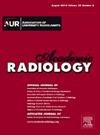肿瘤表观弥散系数与肝内胆管癌早期复发有关
IF 3.8
2区 医学
Q1 RADIOLOGY, NUCLEAR MEDICINE & MEDICAL IMAGING
引用次数: 0
摘要
理由和目标:识别肝内胆管癌(iCCA)早期复发(ER)高风险患者可指导个性化治疗策略并提高生存率。本研究旨在探讨术前磁共振成像(尤其是弥散加权成像)在预测早期复发(ER)(包括接受新辅助治疗的患者)方面的价值:本研究纳入了175例经病理证实接受根治性切除术的iCCA患者(男性114例,女性61例;平均年龄59.0 ± 9.56岁)。对 MRI 特征,尤其是表观弥散系数(ADC)进行了分析,并对 ER 和非 ER 病例进行了比较。采用 Cox 回归和 Kaplan-Meier 分析法评估了 ER 的生存分析:结果:54.3%的患者(95/175)发生了ER。多变量逻辑回归分析发现,肿瘤 ADC 是ER 的唯一独立预测因子(几率比 = 0.034,P -3 mm2/s)。在预测ER方面,肿瘤ADC与AJCC第8期分期系统相当(测试队列的AUC为0.758 vs 0.650,验证队列的AUC为0.779 vs 0.661)。多变量 Cox 分析确定了高肿瘤负荷评分(HR = 1.109,P = 0.009)、非平滑边缘(HR = 2.265,P = 0.008)和肿瘤 ADC(HR = 0.111,P 结论:MRI 和 ADC 预测ER 的准确率分别为 0.758 和 0.650:无论是否采用新辅助治疗,术前磁共振成像(尤其是 ADC)都能帮助预测 iCCA 的 ER,与 AJCC 第 8 期分期系统相当。本文章由计算机程序翻译,如有差异,请以英文原文为准。
Tumor Apparent Diffusion Coefficient is Associated with Early Recurrence of Intrahepatic Cholangiocarcinoma
Rationale and Objectives
Identifying intrahepatic cholangiocarcinoma (iCCA) patients who are at high risk for early recurrence (ER) can guide personalized treatment strategy and improve survival. This study aimed to investigate the value of preoperative MRI, especially diffusion-weighted imaging, in predicting ER, including in patients receiving neoadjuvant therapy.
Materials and methods
This study included 175 pathologically-confirmed iCCA patients who underwent curative resection (114 men, 61 women; mean age 59.0 ± 9.56 years). MRI features, particularly apparent diffusion coefficient (ADC), were analyzed and compared between ER and non-ER cases. Survival analyses of ER were evaluated using Cox regression and Kaplan-Meier analysis.
Results
ER occurred in 54.3% (95/175) of patients. Multivariate logistic regression analysis identified tumor ADC as the only independent predictor of ER (odds ratio = 0.034, P < 0.001), with AUCs of 0.758 (95%CI 0.664, 0.836) in the testing cohort and 0.779 (95%CI 0.622, 0.893) in the validation cohort. The optimal ADC threshold was 1.273 × 10−3 mm2/s. Tumor ADC was comparable to the AJCC 8th staging system in predicting ER (AUC 0.758 vs 0.650 in testing cohort and 0.779 vs 0.661 in validation cohort). Multivariate Cox analysis identified high tumor burden score (HR = 1.109, P = 0.009), non-smooth margin (HR = 2.265, P = 0.008) and tumor ADC (HR = 0.111, P < 0.001) as independent risk factors for ER. Lower ADC values were linked to shorter RFS in both testing and validation cohorts (P < 0.001 and 0.0219), as well as in patients receiving neoadjuvant therapy (P = 0.003).
Conclusion
Preoperative MRI, particularly ADC, can help predict ER in iCCA, regardless of the application of neoadjuvant therapy, comparable to the AJCC 8th staging system.
求助全文
通过发布文献求助,成功后即可免费获取论文全文。
去求助
来源期刊

Academic Radiology
医学-核医学
CiteScore
7.60
自引率
10.40%
发文量
432
审稿时长
18 days
期刊介绍:
Academic Radiology publishes original reports of clinical and laboratory investigations in diagnostic imaging, the diagnostic use of radioactive isotopes, computed tomography, positron emission tomography, magnetic resonance imaging, ultrasound, digital subtraction angiography, image-guided interventions and related techniques. It also includes brief technical reports describing original observations, techniques, and instrumental developments; state-of-the-art reports on clinical issues, new technology and other topics of current medical importance; meta-analyses; scientific studies and opinions on radiologic education; and letters to the Editor.
 求助内容:
求助内容: 应助结果提醒方式:
应助结果提醒方式:


